HRL Laboratories, LLC has demonstrated proof-of-concept on a unique approach to achieve a silent pumping system that replaces traditional mechanical moving parts with an electric current and a magnetic field. This work is being performed under Defense Advanced Research Project Agency’s (DARPA) “Principles of Undersea Magnetohydrodynamic Pumps (PUMP)” program.
This press release features multimedia. View the full release here: https://www.businesswire.com/news/home/20250402031549/en/

HRL Laboratories proof-of-concept delivers quiet, reliable propulsion for marine applications similar to the fictional approach used in the 1990 film “The Hunt for Red October.” Designed for DARPA, the new propulsion system will have no moving parts and provide thrust using electromagnets and water.
HRL’s new device uses a recirculating electrochemical hydrogen cell which enables a prototype magnetohydrodynamic (MHD) pump that could be 70% efficient as well as highly reliable – with a lifespan of more than 5 years. Key design benefits:
- Nearly eliminates gas bubbles – producing 95% fewer bubbles than traditional electrolysis cells – to deliver quiet, gas-free pumping
- Produces no oxidative or corrosive elements (O2 or Cl2) which degrade electrode performance over time
Magnetohydrodynamic (MHD) pumps:
MHD pumps, which generate force from a magnetic field acting on an electric current flowing through seawater, require no rotating mechanical components. This approach significantly reduces noise while simultaneously increasing reliability in comparison to conventional propeller- or impeller-based systems. In a typical MHD pump, a DC electrical current is passed through a volume of seawater, which interacts with an applied magnetic field, resulting in a Lorentz force on the ions in the water. As the ions accelerate, they drag the water molecules and generate thrust.
HRL’s concept includes uniquely tailored gas-diffusion electrodes in its MHD model. This innovation ensures that the hydrogen gas generated at the cathode does not form bubbles but instead diffuses-out to the back side of the electrode. The resulting H2 gas is then routed to the back side of the anode where it diffuses-in and is consumed. This completes the recirculation loop while preventing corrosive oxygen and chlorine bubbles from forming at the anode.
“With the successful demonstration of a viable method to achieve an efficient, quiet and reliable MHD pump, we hope that HRL will next have the opportunity to build a complete prototype test system for the U.S. Navy for further testing,” said Jason Graetz, principal investigator at HRL Laboratories.
History of magnetohydrodynamic (MHD) drive technology:
Since the 1960s, academic, commercial and military researchers have attempted to realize a novel form of maritime propulsion involving no moving parts – no propeller, no drive shaft, no seals – just magnets and an electric current that silently propel a marine vessel through water. Developers have had some success over the decades demonstrating MHD drive technology on a small scale, but it has been inefficient and impractical for full-scale systems. HRL's new approach to MHD offers a promising solution to overcoming some of these challenges.
Notable partners:
- General Atomics will design and build the high-temperature superconducting (HTS) magnets required for the MHD pump.
- University of Illinois will provide experience in electrochemical and corrosion modeling to develop a modeling and simulation toolset that will guide the electrode design to meet the project’s specifications.
HRL Laboratories, LLC, California (www.hrl.com) pioneers the next frontiers of physical and information science. Delivering transformative technologies in automotive, aerospace and defense, HRL advances the critical missions of its customers. As a private company owned jointly by Boeing and GM, HRL is a source of innovations that advance the state of the art in profound and far-reaching ways.
View source version on businesswire.com: https://www.businesswire.com/news/home/20250402031549/en/
With the successful demonstration of a viable method to achieve an efficient, quiet and reliable MHD pump, we hope that HRL will next have the opportunity to build a complete prototype test system for the U.S. Navy for further testing
Contacts
media@hrl.com
310-317-5000
